Aetna Reports Second-Quarter 2012 Results
|
|
HARTFORD, Conn., July 31, 2012 — Aetna (NYSE: AET) today announced second-quarter 2012 operating earnings(1) of $452.0 million, or $1.31 per share, compared to the $1.35 per share reported in the second quarter of 2011. Favorable before-tax prior-period reserve development in the second quarters of 2012 and 2011 was approximately $38 million and $188 million, respectively. Excluding the after-tax impact of this development, operating earnings were $427.9 million and $401.5 million in the second quarters of 2012 and 2011, respectively, and increased in 2012 primarily due to higher underwriting margins and increased membership in our Medicare business.
Group Insurance business results Group Insurance, which includes group life, disability and long-term care products, reported:
Large Case Pensions business results Large Case Pensions, which manages a variety of discontinued and other retirement and savings products, primarily for qualified pension plans, reported:
Total company results
Aetna's conference call to discuss second-quarter 2012 results will begin at 8:30 a.m. ET today. The public may access the conference call through a live audio webcast available on Aetna's Investor Information link on the Internet at www.aetna.com. Financial, statistical and other information, including GAAP reconciliations, related to the conference call also will be available on Aetna's Investor Information website.
This press release also includes presentations of operating earnings for the three months ended June 30, 2012 and 2011 excluding development of prior-period health care cost estimates. Management believes these measures provide a useful comparison of Aetna's underlying business performance where there are significant differences in prior-period development from period to period. For a reconciliation of these items to financial measures calculated under U.S. generally accepted accounting principles ("GAAP"), refer to the tables on pages 8 through 10 and 12 of this press release. (2) Projected operating earnings per share exclude from net income any future net realized capital gains and losses and other items, if any, that neither relate to the ordinary course of our business nor reflect our underlying business performance. Aetna is not able to project the amount of future net realized capital gains and losses or any such other items and therefore cannot reconcile projected operating earnings per share to projected net income per share in any period. Projected operating earnings per share for the full year 2012 reflect a range of approximately 344 million to 347 million weighted average diluted shares. (3) Revenue excludes net realized capital gains and losses as noted in (1) above. Refer to the tables on pages 9, 10 and 12 of this press release for a reconciliation of revenue excluding net realized capital gains and losses to revenue calculated under GAAP. (4) The business segment operating expense ratio reflects the exclusion of the Corporate Financing segment from operating expenses and excludes net realized capital gains and losses and other items, if any. For a reconciliation of this metric to the comparable GAAP measure refer to page 10 of this press release. (5) In order to provide useful information regarding Aetna's profitability on a basis comparable to others in the industry, without regard to financing decisions, income taxes or amortization of other acquired intangible assets (each of which may vary for reasons not directly related to the performance of the underlying business), Aetna's pretax operating margin is based on operating earnings excluding interest expense, income taxes and amortization of other acquired intangible assets. Management also uses pretax operating margin to assess Aetna's performance, including performance versus competitors. (6) Revenue and operating expense information is presented before income taxes. Operating earnings is presented net of income taxes. (7) Our Corporate Financing segment is not a business segment. It is added to our business segments to reconcile to our consolidated results. The Corporate Financing segment includes interest expense on our outstanding debt and the financing components of our pension and other postretirement benefit plan expenses (benefits). (8) Represents members in consumer-directed health plans included in Aetna's Commercial medical membership. (9) Represents members in products that allow these members access to Aetna's dental provider network for a nominal fee. CAUTIONARY STATEMENT; ADDITIONAL INFORMATION -- -- Certain information in this press release is forward-looking, including our projections as to operating earnings per share, medical membership and weighted average diluted shares. Forward-looking information is based on management's estimates, assumptions and projections, and is subject to significant uncertainties and other factors, many of which are beyond Aetna's control. Important risk factors could cause actual future results and other future events to differ materially from those currently estimated by management, particularly the implementation of health care reform legislation and changes in Aetna's future cash requirements, capital requirements, results of operations, financial condition and/or cash flows. Health care reform will significantly impact our business operations and financial results, including our medical benefit ratios. Components of the legislation will be phased in over the next six years, and we will be required to dedicate material resources and incur material expenses during that time to implement health care reform. Many significant parts of the legislation, including health insurance exchanges, Medicaid expansion, the scope of "essential benefits," employer penalties and the implementation of minimum medical loss ratios, require further guidance and clarification at the federal level and/or in the form of regulations and actions by state legislatures to implement the law. In addition, pending efforts in the U.S. Congress to repeal, amend, or restrict funding for various aspects of health care reform, the 2012 presidential and congressional elections, and the possibility of additional litigation challenging aspects of the law continue to create additional uncertainty about the ultimate impact of health care reform. As a result, many of the impacts of health care reform will not be known for the next several years. Other important risk factors include adverse and less predictable economic conditions in the U.S. and abroad (including unanticipated levels of, or increases in the rate of, unemployment); adverse changes in health care reform and/or other federal or state government policies or regulations as a result of health care reform or otherwise (including legislative, judicial or regulatory measures that would affect our business model, restrict funding for or amend various aspects of health care reform, limit our ability to price for the risk we assume and/or reflect reasonable costs or profits in our pricing, such as mandated minimum medical benefit ratios, eliminate or reduce ERISA pre-emption of state laws (increasing our potential litigation exposure) or mandate coverage of certain health benefits); our ability to differentiate our products and solutions from those offered by our competitors, and demonstrate that our products lead to access to better quality of care by our members; unanticipated increases in medical costs (including increased intensity or medical utilization as a result of flu, increased COBRA participation rates or otherwise; changes in membership mix to higher cost or lower-premium products or membership-adverse selection; changes in medical cost estimates due to the necessary extensive judgment that is used in the medical cost estimation process, the considerable variability inherent in such estimates, and the sensitivity of such estimates to changes in medical claims payment patterns and changes in medical cost trends; increases resulting from unfavorable changes in contracting or re-contracting with providers, and increased pharmacy costs); failure to achieve and/or delays in achieving desired rate increases and/or profitable membership growth due to regulatory review or other regulatory restrictions, the difficult economy and/or significant competition, especially in key geographic areas where membership is concentrated, including successful protests of business awarded to us; adverse changes in size, product mix or medical cost experience of membership; our ability to diversify our sources of revenue and earnings; adverse program, pricing or funding actions by federal or state government payors, including curtailment or elimination of the Centers for Medicare & Medicaid Services' star rating bonus payments; the ability to reduce administrative expenses while maintaining targeted levels of service and operating performance; the ability to successfully implement our agreement with CVS Caremark Corporation on a timely basis and in a cost-efficient manner and to achieve projected operating efficiencies for the agreement; our ability to integrate, simplify, and enhance our existing information technology systems and platforms to keep pace with changing customer and regulatory needs; the success of our health information technology initiatives; our ability to successfully integrate our businesses (including Medicity, Prodigy Health Group, PayFlex, and Genworth Financial Inc.'s Medicare Supplement business and other businesses we acquire in the future) and implement multiple strategic and operational initiatives simultaneously; managing executive succession and key talent retention, recruitment and development; the outcome of various litigation and regulatory matters, including guaranty fund assessments and litigation concerning, and ongoing reviews by various regulatory authorities of, certain of our payment practices with respect to out-of-network providers and/or life insurance policies; reputational issues arising from our social media activities, data security breaches, other cybersecurity risks or other causes; the ability to develop and maintain relations with providers while taking actions to reduce medical costs and/or expand the services we offer; our ability to maintain our relationships with third party brokers, consultants and agents who sell our products; increases in medical costs or Group Insurance claims resulting from any epidemics, acts of terrorism or other extreme events; and a downgrade in our financial ratings. For more discussion of important risk factors that may materially affect Aetna, please see the risk factors contained in Aetna's 2011 Annual Report on Form 10-K ("Aetna's Annual Report") and Aetna's Quarterly Report on Form 10-Q for the quarter ended March 31, 2012 (Aetna's "First Quarter 10-Q"), each on file with the Securities and Exchange Commission (the "SEC"), and Aetna's Quarterly Report on Form 10-Q for the quarter ended June 30, 2012 (together with Aetna's First Quarter 10-Q, Aetna's "Quarterly Reports"), when filed with the SEC. You also should read Aetna's Annual Report and Aetna's Quarterly Reports for a discussion of Aetna's historical results of operations and financial condition. |



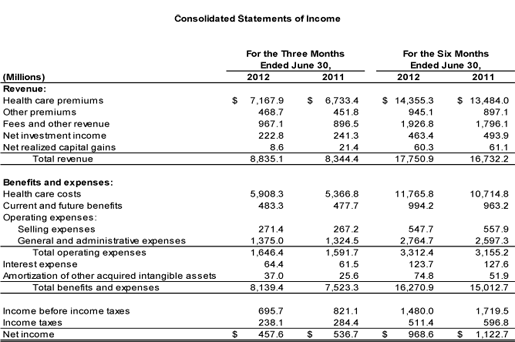
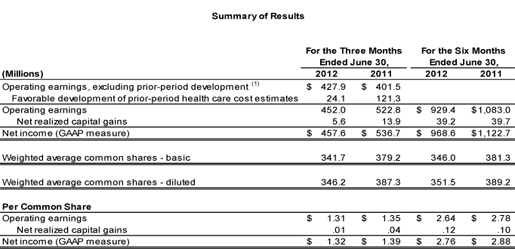
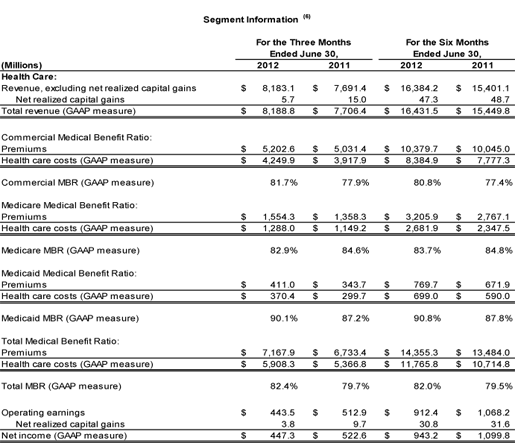
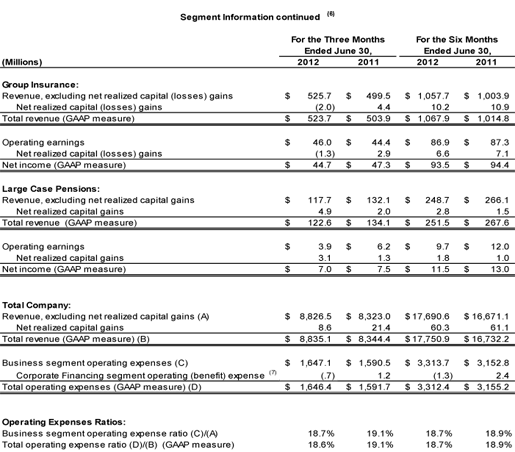
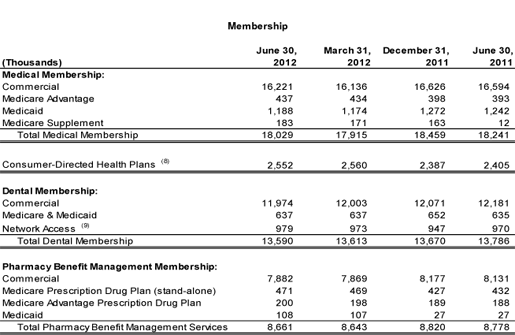
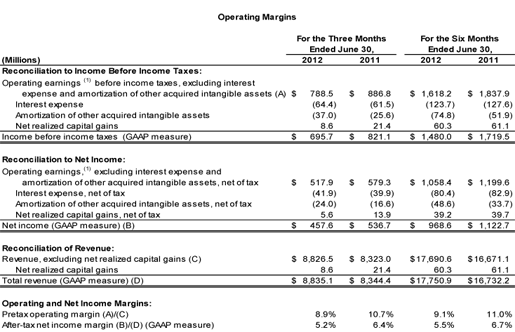
 FEEDBACK
FEEDBACK